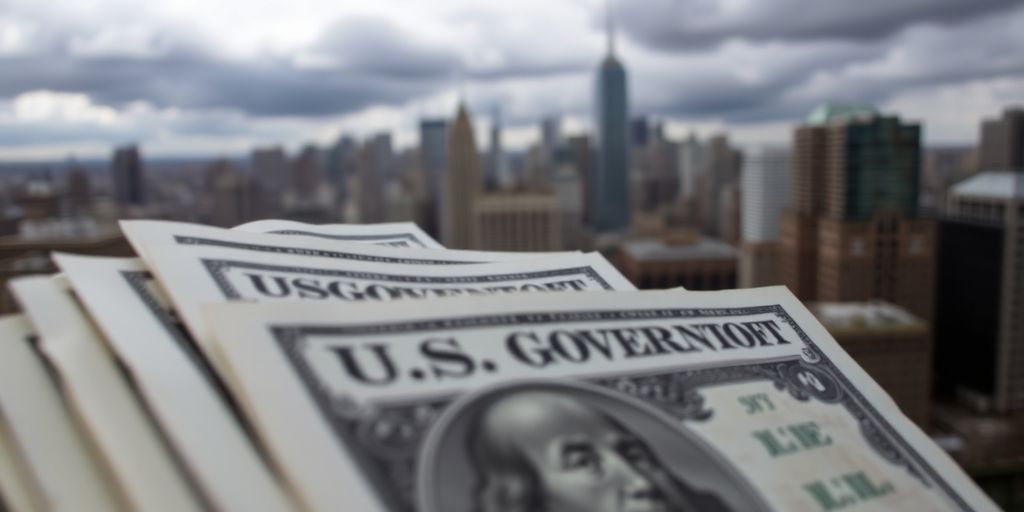Business
US Government Bonds Face Unprecedented Sell-Off Amid Economic Turmoil

Investors are increasingly losing confidence in US government bonds, leading to a significant sell-off that has raised alarms among financial experts. This unusual trend comes as economic uncertainty looms, driven by fluctuating market conditions and concerns over the stability of US fiscal policy.
Key Takeaways
- Investors are dumping US government bonds, traditionally seen as a safe haven.
- The yield on the 10-year Treasury bond has surged from 4.01% to around 4.50%.
- Higher bond yields could lead to increased borrowing costs for consumers and businesses.
- Experts express concerns over the US losing its status as a reliable financial partner.
The Current State of US Government Bonds
The recent sell-off of US government bonds marks a stark departure from the norm, where investors typically flock to these securities during times of economic distress. The US Treasury bonds, which serve as IOUs from the government, are losing their appeal even as yields rise, indicating a troubling shift in investor sentiment.
Historically, Treasury bonds have been viewed as a safe investment, especially during market volatility. However, the current climate has seen a notable decline in demand, with major financial institutions and individual investors alike opting to sell rather than buy.
Rising Yields and Their Implications
The yield on the 10-year Treasury bond has experienced a dramatic increase, climbing from 4.01% to as high as 4.58% before stabilizing around 4.50%. This spike in yields is significant, as it reflects a broader loss of confidence in the US economy and its fiscal policies.
- Impact on Borrowing Costs: As bond yields rise, so too do interest rates on mortgages, car loans, and other forms of credit. This could lead to higher monthly payments for consumers and increased costs for businesses.
- Corporate Financing: Companies that rely on these funding markets may face higher expenses, potentially leading to increased prices for consumers or cuts in workforce to manage costs.
Factors Behind the Sell-Off
Several factors contribute to the current bond market turmoil:
- Economic Sentiment: Recent reports indicate a decline in consumer sentiment, with expectations of rising inflation further unsettling investors.
- Political Instability: The erratic nature of US trade policies, particularly under the Trump administration, has made the country appear less stable and reliable as a financial partner.
- Market Dynamics: Some hedge funds are reportedly facing pressure to liquidate their positions, contributing to the sell-off.
The Future of US Bonds
While the current situation is concerning, experts remain divided on the long-term implications. Some believe that the sell-off may be temporary, while others warn that a sustained loss of confidence could have dire consequences for the US economy.
- Potential Recovery: If Treasurys are no longer seen as a safe haven, investors may seek alternative investments, but options are limited.
- Market Reactions: The bond market’s response to fiscal policies can significantly influence political decisions, as seen in past administrations.
In conclusion, the ongoing sell-off of US government bonds highlights a critical juncture for the US economy. As investors reassess their confidence in the stability of US fiscal policy, the implications for consumers and businesses could be profound, warranting close attention from policymakers and market participants alike.
Sources
-

 Press Release4 days ago
Press Release4 days agoClinical Trials Market Set for Robust Growth, Driven by Drug Development Surge and Digital Innovation
-

 Press Release7 days ago
Press Release7 days agoBellarium ($BEL) Price Prediction: Could It Hit $5 by 2026?
-

 Press Release5 days ago
Press Release5 days agoIndustrial Boiler Market Expected to Surpass USD 24.4 Billion by 2035 Amid Growing Demand for Energy Efficiency and Industrialization
-

 Business6 days ago
Business6 days agoHow Managed IT Solutions Help Small Teams Compete at Enterprise Scale
-

 Press Release5 days ago
Press Release5 days agoPreventive Vaccines Market to Witness Strong Growth by 2035
-

 Press Release5 days ago
Press Release5 days agoGreen Bio Chemicals Market Poised for Sustainable Growth amidst Global Shift to Eco-Friendly Alternatives by 2035
-

 Press Release5 days ago
Press Release5 days agoFill-Finish Pharmaceutical Contract Manufacturing Market Expected to Flourish Amid Biopharmaceutical Boom and Global Outsourcing Trend by 2035
-

 Press Release5 days ago
Press Release5 days agoPet Food Nutraceutical Market Set for Robust Expansion Amid Rising Demand for Pet Wellness by 2035










